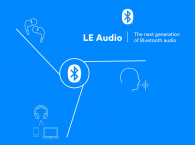
At the end of 2016, audioXpress asked the Bluetooth SIG to clarify the implications and potential areas of development for audio applications using Bluetooth. We learned then from Mark Powell that the member companies were working on a specification update to address audio specific enhancements, for publication later in 2017. We wanted to better understand how this would work and how companies could better prepare - and eventually contribute - to this audio-specific work, which is generating huge expectations for the industry.
audioXpress : Can you give us more details on the Bluetooth SIG calendar for Bluetooth 5, specifically in terms of the announced Bluetooth audio specification?
Mark Powell : Sure. The organization is currently working on the next generation of Bluetooth audio. What that generation will mean is new use cases, point-to-multipoint broadcast type scenarios, multichannel scenarios, better codecs, taking advantage of the low energy radio, etc.
That work is under way, it's something that's probably more likely to come to the market next year, but the SIG members are working on it right now. Some of the technology you can already see today, in hearing aids - there are already Bluetooth hearing aids using the kind of things that we are putting into the standard. The whole idea about Bluetooth is that we have lots of member companies and they come together and they collaborate on the standard. And that's why the market is bigger because everything works together properly.
With Bluetooth 5 we are starting to talk a lot more ahead of the publication. We'll start talking about the use cases, that are supported, and the market propositions. It's more about getting the marketing message ready, and then of course when the specification is published then we can talk in detail on how this works. Until then, we provide developers support in terms of tools, we will have all the testing systems, available for people to qualify their products and make sure they are interoperable. So, there's a sequence of events...

Mark Powell : That's true, because the applicability is immediate. You can make sensor devices that have longer range and immediately be using that part of Bluetooth 5. But Bluetooth 5 is also a step forward in creating a robust platform because you have the longer range with error correction, and faster speeds, so now we can have 2 Mbps in the radio link, which of course is helpful for audio applications, and the idea down the road is - as I said - that this new specification takes advantage of that in better use cases, additional use cases, better codecs, etc.
It certainly is a robust platform to build audio applications, and all the work that is happening right now is assuming this platform.
audioXpress : Will the longer range and faster speeds inspire whole-home and multizone type of audio applications or enable more efficient and better quality personal experiences?
Mark Powell : Multiroom is one of the scenarios that the guys are working on. Another piece of technology that's coming and could be useful is mesh connections between devices. We will release a mesh specification later this year, and that will allow connections between devices and relaying of signals. That can help in a multiroom situation. But the guys are also addressing the issues with synchronization, latency, and those kinds of things. All I can say is there's work in progress and our goal is to create something that is truly interoperable. We know we can always do better. Every release that we make has lots of additional fixes. It's always advancing all the time, and we pride ourselves on Bluetooth having the best out-of-the-box connectivity. It certainly could be better but it is already better than other technologies. So, they must have a rigor so that the process of creating a specification makes sure that it exceeds the quality of what we had before.
At the same time we have work going on to improve the experience for people when they are connecting their devices for the first time. We know people currently are not happy with the pairing experience... It's OK, but that's part of the reliability and we are going to improve that and add different mechanisms to improve that process.

is a wireless industry veteran and entrepreneur
with more than 25 years, experience in leadership
positions at some of the industry's largest
mobile technology providers.
Mark Powell : Only a little bit... and let me explain why. The way the Bluetooth SIG works is that the member companies get together and they work on the specification. Meanwhile, at the same time, those same companies are working on other forums to do something in a different field. Probably, that work is well connected at the company level, but one of the challenges for us is that the work that the members are doing, before it's published, is actually confidential. So, that makes it difficult for us to work with organizations like the IEEE (Institute of Electrical and Electronics Engineers) or the IETF (Internet Engineering Task Force) because they're open and public organizations. We can't have discussions about our confidential work with public organizations. That's just the nature of our work.
We have to rely on what we call members in common, where the same companies are doing work. We do collaborate. NFC and Bluetooth was the result of a collaboration some years ago to create the touch-to-pair mechanism, and there was some collaboration defining the requirements. We do that, but it can be challenging and more often we will rely on our members in common to make sure there's communication.
audioXpress : Among the members collaborating on the new audio specification, are there any companies defending the quality-audio experience instead of the more telecom-oriented applications?
Mark Powell : Yes. Obviously there's a constraint on the speed of the radio link but beyond that, our members are thinking about the quality. When you consider what the Bluetooth audio experience was when it first came, 15 years ago... the kind of DSPs and CPUs you had back then were much less powerful. These days you can have very complex codecs and have very efficient air links, so we certainly want to take advantage of that, for sure, and that will be something that will be coming in the new specification. They are also considering the end-to-end scenarios so there's no transcoding. Today, for example, when you are streaming from Pandora or Spotify, there's transcoding happening in the device to go from the streaming cloud service to the Bluetooth device. Considering opportunities to have no transcoding of course improves quality.
audioXpress : Three years ago, one would assume that consumer wireless home audio applications would be predominantly over Wi-Fi. Now, on that front there is a battle between proprietary implementations (Qualcomm, DTS, Sonos, etc), while Bluetooth seems to be stepping into that same space...
Mark Powell : Yes. And I think there are reasons for that. Bluetooth is cheaper to implement and Bluetooth is lower power. Those are two of the more obvious reasons. But less obvious is interoperability. Bluetooth worked very hard to make sure that anybody's speaker can work with anybody's smartphones, for example. The other thing is the time and money that we've put in to support developers. We have a full range of tools, training testing materials, things that don't exist with other technologies. As well as cost, and low power and interoperability. Why would people choose anything else, when I can quickly bring my product to market because Bluetooth provides me with all these tools? In my mind, that's why we have hundreds of millions of devices - just released in the past year - and all using Bluetooth.

Mark Powell : We can cooperate with other organizations but, what works best is for our members to get together and create what we call a new work item. If that new work item gathers enough support from a broader group of members, then we move into a requirement phase, and everybody can contribute to what should be the requirements. And once those are complete, then specification development starts. There's a well-defined process, which is triggered by individual member companies saying "yes, we want to support this work."
So, the best way would be for companies who would like to see these things happen - and I would be surprised if they're not members of Bluetooth SIG already... - to create a new work idea and make that become a proposal. Even if they're just a regular member, they can create the proposal.
audioXpress : Can you tell us something about the test platforms that are available for Bluetooth 5 implementation?
Mark Powell : There are 8 to 10 platforms that are validated to test the radio part. Then we have protocol testing. We only have one platform for that but there's a new one coming. And for the profiles we have an internal test system that pretends to be either end of the Bluetooth link. For example, I can pretend to be a smartphone or a tablet and test a speaker or I can pretend to be a speaker... The tool is free to use and runs off a PC.
In terms of audio quality testing, that's a different area and something we are looking into. We don't have a decided platform for those kinds of things. All the usual suspects will be there, I'm sure. Many of our members already have what's required, since they already have to do that testing for the handset manufacturers. We also have a number of companies, who have registered test facilities and they already have this equipment and they can provide that service..
This interview was originally published in The Audio Voice newsletter, March 23, 2017.










